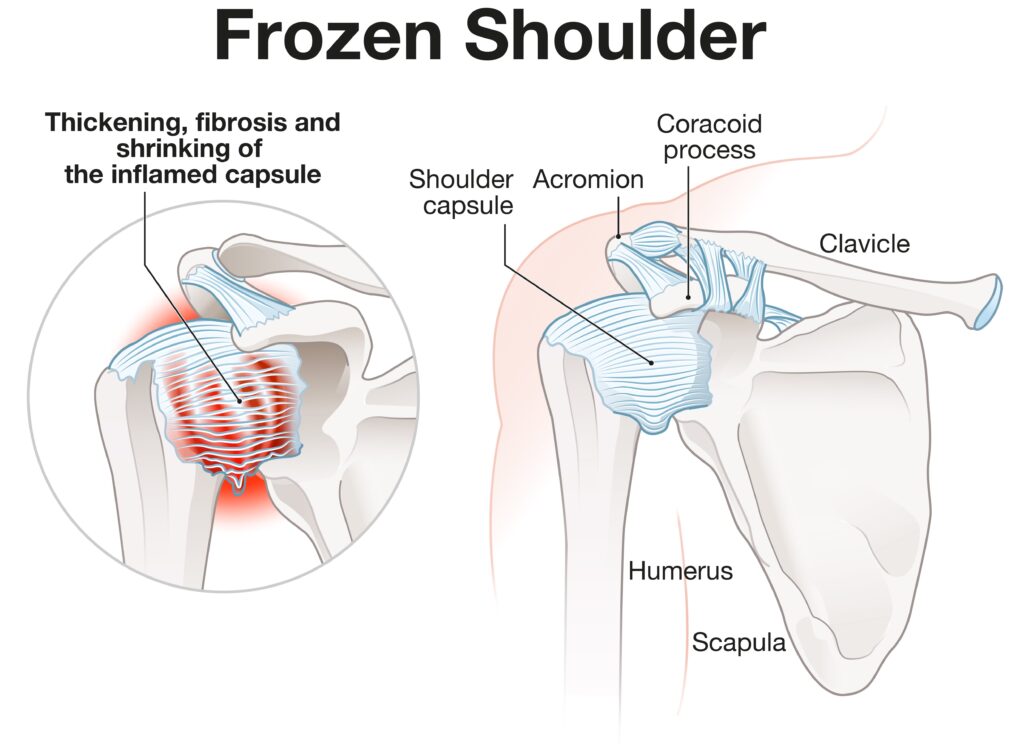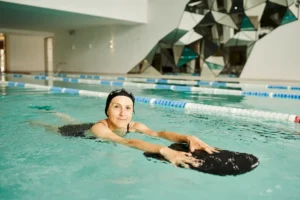Frozen shoulder, also known as adhesive capsulitis, is a condition characterized by pain and stiffness in the shoulder (glenohumeral) joint. It results from the gradual loss of movement in the shoulder joint. The shoulder is normally one of the most mobile joints in the body. When frozen shoulder sets in, the joint becomes stuck and gradually movement becomes limited. It may be difficult and painful to move the arm away from the body or above the head.
What causes frozen shoulder?
Like many shoulder diseases, frozen shoulder creates pain and loss of motion. Frozen shoulder is typically caused by inflammation or swelling of the tissues surrounding the shoulder joint. The tissue that surrounds the joint and holds it together is called the capsule. A healthy capsule has folds that can expand and contract, helping the arm move.

In the case of frozen shoulder, the capsule becomes inflamed and tight, developing scarring around the joint. These scars are called adhesions, known as adhesive capsulitis (inflammation of the capsule). As the capsule tightens from scarring, movement of the shoulder joint becomes painful and restricted.
It is unclear why this happens to some people, but it’s more likely to happen after the shoulder has been immobile (after an arm injury or surgery, for instance). Inflammation of the muscles and/or tendons, as with rotator cuff tendinitis or bursitis, can also cause the shoulder joint to become frozen.
Treatment for frozen shoulder
The main goal in treating a frozen shoulder is to increase motion and decrease pain. Treatment typically involves physical therapy focused on range of motion exercises. A physical therapist may use ice, heat, ultrasound or electrical stimulation to help increase joint mobility.
Over the counter pain medications to relieve pain and stiffness may also help. In some cases, a corticosteroid injection into the joint may be necessary. Surgery is very rarely needed early on, but with more severe cases lasting greater than six to nine months it is not unreasonable to consider surgery as it may help restore range of motion and loosen the joint capsule.
Physical therapy can last from one to six weeks, with visits being one to three times per week depending on what is recommended by your doctor. Diligently preforming home exercises and stretching throughout the healing process is important for a full recovery. Frozen shoulder may resolve almost completely with time and consistency if the prescribed treatment program is followed. The recovery process can take around four months to a year for some patients, depending on the severity and the rehabilitation program. The key to a successful recovery from a frozen shoulder is early recognition and treatment. Adherence to therapy and diligence with stretching goes a long way.
How is a frozen shoulder diagnosed?
The first step Dr. Giang will take in order to diagnose a frozen shoulder is to complete a history and physical examination. Several tests, such as X-rays, ultrasound, or MRI can help rule out other potential causes that may be causing your shoulder to remain painful or have limited motion. Although frozen shoulder can often times occur for no apparent reason, it is important to rule out other conditions that may include arthritis, ligament tears, calcium deposits, etc.
How to prevent the risk of frozen shoulder
There are certain factors that may increase the risk of developing frozen shoulder, including age and health. Frozen shoulder is often seen in patients aged 40 and older, and typically more common in women.
People who may be at higher risk for developing frozen shoulder are often those who have had restricted movement due to a rotator cuff injury, broken arm, recovery from surgery, or stroke. Certain diseases appear more likely to cause frozen shoulder, including diabetes, cardiovascular disease, hyperthyroidism, hypothyroidism, and Parkinson’s.
To prevent frozen shoulder, it is recommended that individuals stretch and exercise to help maintain mobility in their shoulders and arms, even when not experiencing pain. People who have suffered from frozen shoulder should also be sure to warm up before exercising and avoid overstretching the affected joint.
If you have suffered an injury that makes it difficult to move your shoulder, it may be time to talk to Dr. Giang about exercises that can help you regain the ability to move your shoulder joint.
Recovery from frozen shoulder
Recovery time for frozen shoulder depends on various factors such as the severity of the condition and the type of treatment used. Cases usually can take three months to a year or more to completely resolve, but frozen shoulder can last much longer in some cases. Recovery time may be a slow process, but with commitment to proper treatment and care, frozen shoulder can generally improve over time.
Frozen shoulder may resolve almost completely with time and consistency if the prescribed treatment program is followed. While it is uncommon, frozen shoulder can recur, especially if factors like diabetes is present. By stretching and exercising, even after motion has been regained, you can help prevent the possibility of a recurrence.
FAQ
Q: What is frozen shoulder?
A: Frozen shoulder, also known as adhesive capsulitis, occurs when the connective tissue around the shoulder joint becomes inflamed and stiff. This makes it difficult to move your arm without experiencing pain. Symptoms may include difficulty reaching overhead and behind you, stiffness and limited range of motion.
Q: What causes frozen shoulder?
A: Frozen shoulder is often caused by a decrease in activity due to an injury, such as a rotator cuff tear, or from overuse. It is typically caused by inflammation or swelling of the tissues surrounding the shoulder joint. Diseases like diabetes and thyroid disorders can also increase your risk for frozen shoulder and may make it more resistant to conservative measures. In some cases, the cause may even be unknown.
Q: How is frozen shoulder treated?
A: The main goal in treating a frozen shoulder is to increase motion and to decrease pain. Treatment typically involves physical therapy focused on range of motion exercises. A physical therapist may use ice, heat, ultrasound or electrical stimulation to also help increase joint mobility. Anti-inflammatory medications, corticosteroid injections and surgical intervention may be used in more severe cases.
Q: Will I need surgery to heal a frozen shoulder?
A: Surgery for frozen shoulder is rare. Surgical intervention may be used in more severe cases, but as a last resort if other non-surgical techniques have failed. The two most common surgical methods include manipulation under anesthesia to stretch the shoulder muscles, or shoulder arthroscopy to remove scar tissue within the joint. Dr. Giang’s preferred method to surgically treat your frozen shoulder includes an arthroscopy to look inside your joint and carefully release the scarring and adhesions to allow for a controlled manipulation and avoid injury to vital structures important for normal shoulder function.
Q: How can I prevent frozen shoulder from occurring?
A: The best way to prevent frozen shoulder is to maintain a healthy lifestyle. This includes regular exercise, stretching and keeping your shoulder muscles strong. If you have had frozen shoulder before, it is important to take extra care when performing activities that can aggravate your shoulder joint and avoid overuse.
Q: How long does it take to recover from frozen shoulder?
A: Recovery time for frozen shoulder can vary from person to person, but it typically can take three months to a year or more for the shoulder joint to regain full mobility. In the meantime, physical therapy and other treatments can help reduce pain and improve range of motion. With diligent care and by following your provided treatment, frozen shoulder can be managed successfully.
Ultimately, frozen shoulder is a condition that requires patience and dedication to ensure full recovery. It is important to be proactive and seek medical attention as soon as you experience any of the symptoms associated with frozen shoulder. Proper management of frozen shoulder can make a huge difference in reducing pain, restoring range of motion and making everyday activities more manageable.
By taking steps to prevent frozen shoulder from occurring, understanding its causes and seeking treatment as soon as possible, you can help ensure successful recovery. And with the right care, frozen shoulder does not have to be a long-term problem.
If you or someone you know suffers from frozen shoulder, schedule a consultation with Dr. Giang, please give us a call
"*" indicates required fields





